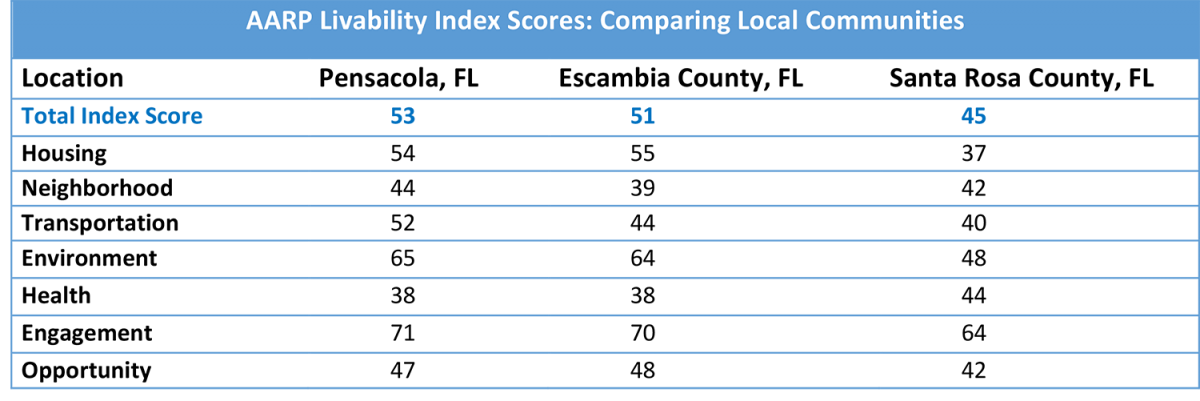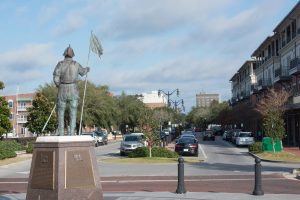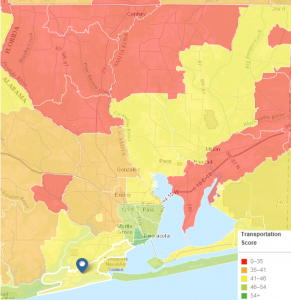AARP Scores Pensacola High on Social Engagement, Low on Health
According to the AARP Livability Index, our local communities are better than average at civic and social engagement but still need to work on maintaining quality neighborhoods and healthy communities.

AARP’s Public Policy Institute launched the Livability Index in April 2015 to help people determine how well their communities meet seven different categories that gauge “livability” for all ages. According to the institute, a livable community is one that is safe and secure, has affordable and appropriate housing and transportation options, and offers supportive community features and services.
According to AARP, nearly 90 percent of people over age 65 want to stay in their home for as long as possible. While it’s true that the metrics highlighted in this tool facilitate aging in place – or the ability to live in one’s home regardless of age, income or ability – they also boost the overall quality of life for the entire community. The tool is usable for multiple layers of geographies, including your county, city, ZIP code, neighborhood or individual address. It can be used for individuals considering a move as well as for local governments assessing potential gaps in services to their residents.
The Livability Index score is based on the averages of seven categories and produces a score on a scale from 0 to 100. These categories are housing, neighborhood, transportation, environment, health, engagement and opportunity.
In addition, there are 40 metrics and 20 policies that support the measurement of each category. The highest score for a city is a 70, earned by La Crosse, Wisconsin, which is similar in size to Pensacola. It is challenging for higher levels of geography to earn high scores since lower geography levels (like individual neighborhoods) may earn a mix of high and low scores.
The scores for the city of Pensacola, Escambia County and Santa Rosa County are all provided in the table for comparison. All three communities earned near the average neighborhood score, with Pensacola rated the highest (53) and Santa Rosa County rated the lowest (45). The table shows that all three areas’ highest scores were in engagement, which includes measures for civic and social engagement, internet access, equal rights and a commitment to livability.

Metrics are also color-coded to indicate if that community’s scores are in the top, middle or bottom third of all neighborhoods across the country. A civic engagement indicator shows that our communities all vote at a higher rate than the median U.S. neighborhood. For example, the city of Pensacola’s 64.2 percent voting rate is compared to a median of 55.6 percent. These rates put the municipality in the top third of all communities.

Pensacola and Escambia County both performed very well overall in the environment category, with scores at 65 and 64 respectively. These communities also scored in the top third for water quality. Moreover, all three communities were ranked in the top third for air quality. Each community had fewer than three unhealthy air quality days per year compared to the median number of eight days for US neighborhoods.
Santa Rosa County was rated in the top third for other metrics as well. In the “Neighborhood” category, the County’s rating was excellent for personal safety based on the crime rate metric of only 153 crimes per 10,000 people. In addition, there was less income inequality in Santa Rosa County than the median U.S. neighborhood or Escambia County.

Transportation was more of a challenge for the three areas, with at least one of the category’s seven metrics falling in the bottom third for each community. One example includes the crash rate, which was higher than the U.S. median for all three areas. The metric for walk trips per day had various results for the regions. While the median U.S. neighborhood has 0.73 walk trips per household per day, the city of Pensacola performed better and in the top third of communities with 1.03 trips per day. In comparison, Escambia County has 0.75 trips per day (the middle third), and Santa Rosa County had 0.61 trips per day (the bottom third).
Other categories also posed a challenge for our communities. The neighborhood category, which measures access to life, work and play, has several metrics in the bottom third, including access to jobs by auto or transit, amount of mixed-use neighborhoods and vacancy rates. Metrics for health – including prevention, access and quality – highlight the area’s high rates of smoking, reduced access to exercise opportunities and a shortage of health care professionals in key neighborhoods.
A key aspect of the Livability Index Tool is that it can be customized to make each category more or less important in the overall score depending on the user’s preferences. For example, it allows people with lower incomes to value affordable housing at a higher rate over other categories, like the neighborhood’s proximity to parks or libraries. This feature acknowledges that different demographic groups may value different things about a community and creates a more user-friendly application.
Amy Newburn is the assistant director of the UWF Haas Center at the University of West Florida in Pensacola.



